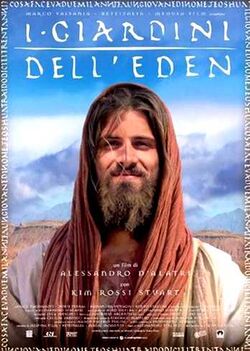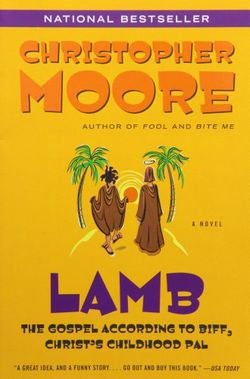Category:Jesus Hidden Years (subject)
Jesus' Hidden Years refers to the "undocumented" events in the life of Jesus following his Childhood, before the beginning of his Ministry.
< Death of Joseph of Nazareth // Cf. Jesus in India -- Jesus at Qumran -- Married Jesus >
< Life of Jesus : Nativity of Jesus -- Childhood of Jesus -- Jesus' Hidden Years -- Ministry of Jesus (Parables of Jesus, Miracles of Jesus) -- Passion of Jesus -- Resurrection of Jesus -- Relics of Jesus >
Overview
Jesus began his ministry when he was in his thirties. Christian tradition provided detailed narrative about the Nativity of Jesus and some glimpses at his Childhood, but was silent about his whereabouts as a young man.
According to the Gospel of Mark, people of his own hometown, Nazareth, referred to him as "the son of Mary" and the brother of , without mentioning any other family members (no father, no wife or children). They also identified him as "the carpenter" (6:3), suggesting that this was his occupation in the village. The Gospel of Matthew used the phrase "the carpenter's son" (13:55) thus mentioning his father and his father's business. The Gospel of Luke generically stated that Jesus "advanced in wisdom and stature, and in favor with God and men" (2:52). No other information was provided.
The curiosity about what would be called "Jesus' Hidden Years" produced only fragments of narrative. By comparing the extant sets of narratives about the Childhood of Jesus and the Ministry of Jesus, it was generally assumed that some events happened during those years:
- Jesus the carpenter = Jesus at Nazareth working as a carpenter
- Death of Joseph of Nazareth = Death of Jesus' father; see History of Joseph the Carpenter
- Jesus Leaving His Mother = Jesus taking leave from his mother before joining John the Baptist
The traditional narrative was that Jesus simply lived at Nazareth with his family (mother, brothers and sisters, as well as his father until he died), worked as "a carpenter" (following his father's business), was not married and had no children, remaining "hidden" and "silent" until the appointed time of his revelation as the Messiah. This is all ancient sources allow us to say. The suggestion has been made (R.A. Batey, 1984, and others) that while living in the village of Nazareth, Jesus might have found employment in nearby Sepphoris which was rebuilt in those years as a major town in the region. But we can only speculate on the whereabouts of Jesus during those years.
Ancient and modern "apocryphal" legends
In the late Middle Ages some legends developed about the presence of Jesus in Britain with Joseph of Arimathea, who in some versions of the story was a merchant and took Jesus under his care after the death of Joseph of Nazareth. These stories have taken new life in contemporary times in some arch-fi works, trying to establish a connection between Jesus and the Druids.
Modern times have seen the emergence of additional (and competitive) narratives to fill the gap between the Childhood of Jesus and the Ministry of Jesus, reflecting the interest in Jesus' personal life and education:
- Jesus in India = Jesus in India in his youth
- Jesus at Qumran = Jesus at Qumran in his youth
- Married Jesus / Jesus Bloodline = Jesus married in his youth and having children
The hypothesis that Jesus travelled to India was first suggested by Russian journalist Nicolas Notovich in 1887. What was a well crafted hoax, based on previous speculations about Jesus being influenced by the teaching of ancient India, has developed today into a complex narrative, involving not only the youth of Jesus but also his survival after the crucifixion and his later death and burial in India; see Jesus in India and Jesus Survival.
The hypothesis that instead Jesus spent some years at Qumran, developed after the discovery of the Dead Sea Scrolls (see Edmund Wilson), but it was also based on some previous speculations about Jesus being a member of the holy Order of the Essenes. In spite of the initial enthusiasm in the Jesus-Qumran connection, the contrast between the teachings of Jesus and the sectarian teachings of the Qumran community makes quite unlikely this hypothesis unless one be eager to speculate on Jesus leaving the sect and rejecting polemically their ideals; see Jesus at Qumran.
Finally, the hypothesis that Jesus was married or was a widower raises some serious historical questions about "virginity" or "celibacy" in Second Temple Judaism, but has only open the door to numerous fancy speculations about Jesus being married with Mary Magdalene and having children, which have no historical foundations and have proven to be very attractive in popular culture; see Married Jesus and Jesus Bloodline.
Jesus' Hidden Years, in scholarly perspective
The discussion about Jesus' Hidden Years has been carried out mainly in works of fiction and arch-fi, and only marginally touched upon in scholarly research. Due to the lack of documentation, it is impossible to "reconstruct" the events of the life of Jesus as a young man. The issues of his education and personal experience before his Ministry are crucial in the research of the Historical Jesus. Scholars reject any speculations about Jesus traveling in Britain or India, or learning his wisdom from Egypt, Greece, India, or the Druids, and focus instead on the Jewish religious environment in which he lived. The diversity of Second Temple Judaism makes it impossible to present Jesus simply as an "ordinary Jew." The question of what kind of Jew Jesus was before beginning his Ministry is inescapable. The fact that he was active in his thirties and ready to answer the call of John the Baptist, seems to point out to an apocalyptic (and perhaps, Essene) setting as the most likely environment in which he grew up and lived as a young man.
@2014 Gabriele Boccaccini, University of Michigan
Jesus' Hidden Years, in ancient sources
Gospel of Mark (1st cent.)
Mk 6:3 -- Isn’t this the carpenter, the son of Mary and brother of James, Joses, Judas, and Simon? And aren’t his sisters here with us?
Gospel of Matthew (1st cent.)
Mt 13:55 -- Isn’t this the carpenter’s son? Isn’t his mother named Mary? And aren’t his brothers James, Joseph, Simon, and Judas?
History of Joseph the Carpenter (6th-7th cent.)
11. Now Justus and Simeon, the elder sons of Joseph, were married, and had families of their own. Both the daughters were likewise married, and lived in their own houses. So there remained in Joseph's house, Judas and James the Less, and my virgin mother. I moreover dwelt along with them, not otherwise than if I had been one of his sons. But I passed all my life without fault. Mary I called my mother, and Joseph father, and I obeyed them in all that they said; nor did I ever contend against them, but complied with their commands, as other men whom earth produces are wont to do; nor did I at any time arouse their anger, or give any word or answer in opposition to them. On the contrary, I cherished them with great love, like the pupil of my eye.
12. It came to pass, after these things, that the death of that old man, the pious Joseph, and his departure from this world, were approaching, as happens to other men who owe their origin to this earth. And as his body was verging on dissolution, an angel of the Lord informed him that his death was now close at hand...
17. ... And I, going in beside him, found his soul exceedingly troubled, for he was placed in great perplexity. And I said to him: Hail! My father Joseph, you righteous man; how is it with you? And he answered me: All hail! My well-beloved son. Indeed, the agony and fear of death have already environed me; but as soon as I heard Your voice, my soul was at rest.
18. When my father Joseph had thus spoken, he was unable to weep more. And I saw that death now had dominion over him. And my mother, virgin undefiled, rose and came to me, saying: O my beloved son, this pious old man Joseph is now dying. And I answered: Oh my dearest mother, assuredly upon all creatures produced in this world the same necessity of death lies; for death holds sway over the whole human race. Even you, O my virgin mother, must look for the same end of life as other mortals. And yet your death, as also the death of this pious man, is not death, but life enduring to eternity. Nay more, even I must die, as concerns the body which I have received from you. But rise, O my venerable mother, and go in to Joseph, that blessed old man, in order that you may see what will happen as his soul ascends from his body.
19. My undefiled mother Mary, therefore, went and entered the place where Joseph was. And I was sitting at his feet looking at him, for the signs of death already appeared in his countenance. And that blessed old man raised his head, and kept his eyes fixed on my face; but he had no power of speaking to me, on account of the agonies of death, which held him in their grasp. But he kept fetching many sighs. And I held his hands for a whole hour; and he turned his face to me, and made signs for me not to leave him. Thereafter I put my hand upon his breast, and perceived his soul now near his throat, preparing to depart from its receptacle.
29. ... I embraced the body of my father Joseph, and wept over it; and they opened the door of the tomb, and placed his body in it, near the body of his father Jacob ...
Jesus' Hidden Years, in literature and the arts
Jesus' Hidden Years, in visual art
Only a few works of art portrait Jesus as a young man. Jesus Hidden Years are almost completely overlooked in traditional Christian iconography, except for some rare representations of the Death of Joseph of Nazareth.
Jesus' Hidden Years, in literature and the movies
Only a few novels or movies have dared speculate on Jesus' Hidden Years, showing Jesus as a young man before the beginning of his Ministry.
In Christus (1916 Antamoro), film, Jesus lived in Egypt until the time of his Baptism. Since Jesus was described as having a clear messianic self-consciousness since his childhood, it was assumed that as a young man in Egypt he did exactly what he later would do in the land of Israel--preaching to the crowds (here the nomads of the desert), praying (meditating over the ruins of the ancient Egyptian monuments), and performing miracles (healing an Egyptian princess). The script was based on a mystic poem by Fausto Salvatori.
The novel Three from Galilee by Marjorie Holmes (1985) offers a fictionalization of what may have been Jesus young adult life from the age of 12 until his public ministry at the age of thirty. It is the second volume of her trilogy devoted to the life of Jesus (childhood / hidden years / ministry). Mary and Joseph have returned to Nazareth, to their families, to start their own family. Jesus is told by his parents that he is the Messiah, and yet lives the ordinary life of the youth of his time: sheperding with his grandfather, loving animals, working in the carpentry shop, enjoying his siblings, the Passover journey to Jerusalem, and his first love, falling in love, when he was 29, with a 17-year-old girl after seeing her bathe in a waterfall. The novel suggests that some of the parables of Jesus may have been inspired by occurrences in the life of his own family.
A completely opposite approach was taken in the The Last Temptation of Christ (1988 Scorsese), film. The movie offers the most ambitious attempt at speculating on Jesus' Hidden Year, as a period in which a dubious Jesus had to struggle to understand his identity and the meaning of his mission.
In Lamb (2002 Moore), novel Jesus and his pal Biff travel to the East (India, China) on a quest to find the Magi.
I giardini dell'Eden (The Garden of Eden / 1998 D'Alatri), film is the first (and only) movie to focus entirely on Jesus' Hidden Years. As a young man, Jesus clashed with the Zealots in Jerusalem, traveled extensively up to India, and joined the Essenes at Qumran (but was troubled by their isolationism). Finally he found his way, following the lead of his cousin John the Baptist and spreading a message of universal love.
- Last Temptation Scorsese.png
External links
Pages in category "Jesus Hidden Years (subject)"
The following 28 pages are in this category, out of 28 total.
1
- Young Jesus (1515 Correggio), art
- The Shadow of Death (1871 Hunt), art
- Die Lücke im Leben Jesu = La vie inconnue de Jésus-Christ (The Unknown Life of Jesus Christ / 1894 @1894 Notovitch), arch-fi book (German ed.)
- La vie inconnue de Jésus-Christ (The Unknown Life of Jesus Christ / 1894 Notovitch), arch-fi book
- The Unknown Life of Jesus Christ (1894 Notovitch), arch-fi (English ed.)
- The Aquarian Gospel of Jesus (1908 Dowling), vision
- La vie cachée de Jésus (1921 Guignebert), book
- What Jesus Read: His Dependence and Independence (1925 Walker), book
- The Childhood of Jesus (1937 Cummins), vision
- The Novice of Qumran (1959 Brogan), novel
- Die verborgenen Jahre Jesu = Les années obscures de Jésus (1962 @1960 Aron / Mahr), non-fiction (German ed.)
- Gli anni oscuri di Gesù = Les années obscures de Jésus (1963 @1960 Aron / Miniussi), non-fiction (Italian ed.)
- Ainsi priait Jésus enfant (1968 Aron), non-fiction
- Jesus lebte in Indien (Jesus Lived in India / 1983 Kersten), arch-fi
- The Lost Years of Jesus (1984 Prophet), arch-fi
- A Search for the Historical Jesus (1994 Hassnain), arch-fi book
- The Gospel of Corax (1996 Park), novel
- King of Travelers: Jesus' Lost Years in India (1999 Martin), arch-fi
2
- Jesus of India (2000 Lee), arch-fi book
- La vita sconosciuta di Gesù = La vie inconnue de Jésus-Christ (The Unknown Life of Jesus Christ / 2000 @1894 Notovitch / Muggia), arch-fi book (Italian ed.)
- (+) Lamb (2002 Moore), novel
- The Issa Tale That Will Not Die: Nicholas Notovitch and His Fraudulent Gospel (2003 Faden), book
- Yeshûa: A Personal Memoir of the Missing Years of Jesus (2006 Law), novel
- Jesus: A Story of Enlightenment (2008 Chopra), novel
- When Jesus Lived in India (2009 Jacobs), arch-fi book
- Jesus: The Explosive Story of the 30 Lost Years and the Ancient Mystery Religions (2010 McCannon), arch-fi book
- The Breath of God (2011 Small), novel
- The Jewish Teachers of Jesus, James, and Jude (2012 DeSilva), book
Media in category "Jesus Hidden Years (subject)"
The following 5 files are in this category, out of 5 total.
- 1960 * Aron.jpg 300 × 400; 22 KB
- 1962-T * Aron en.jpg 177 × 285; 5 KB
- 1985 * Holmes (novel).jpg 1,125 × 1,500; 197 KB
- 1988 * Scorsese (film).png 300 × 459; 57 KB
- 1998 D'Alatri (film).jpg 348 × 488; 25 KB











